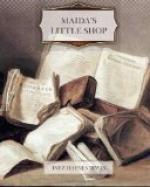Maida went about identifying the places with little cries of joy. “Ara Coeli—I saw in there the little wooden bambino who cures sick people. It’s so covered with bracelets and rings and lockets and pins and chains that grateful people have given it that it looks as if it were dressed in jewels. The bambino’s such a darling little thing with such a sweet look in its face. That’s St. Agnes outside the wall—I saw two dear little baby lambs blessed on the altar there on St. Agnes’s day. One was all covered with red garlands and the other with green. Oh, they were such sweethearts! They were going to use the fleece to make some garment for the pope. That’s Santa Maria della Salute—they call it Santa Maria della Volute instead of Salute because it’s all covered with volutes.” Maida smiled sunnily into Mrs. Lathrop’s face as if expecting sympathy with this architectural joke.
But Mrs. Lathrop did not smile. She looked a little staggered. She studied Maida for a long time out of her shrewd, light eyes.
“Whose family did you travel with?” she asked at last.
Maida felt a little embarrassed. If Mrs. Lathrop asked her certain questions, it would place her in a very uncomfortable position. On the one hand, Maida could not tell a lie. On the other, her father had told her to tell nobody that she was his daughter.
“The family of Mr. Jerome Westabrook,” she said at last.
“Oh!” It was the “oh” of a person who is much impressed. “‘Buffalo’ Westabrook?” Mrs. Lathrop asked.
“Yes.”
“Did your grandmother, Mrs. Flynn, go with you?”
“Yes.”
Mrs. Lathrop continued to look very hard at Maida. Her eyes wandered over the little blue frock—simple but of the best materials—over the white “tire” of a delicate plaided nainsook, trimmed with Valenciennes lace, the string of blue Venetian beads, the soft, carefully-fitted shoes.
“Mr. Westabrook has a little girl, hasn’t he?” Mrs. Lathrop said.
Maida felt extremely uncomfortable now. But she looked Mrs. Lathrop straight in the eye. “Yes,” she answered.
“About your age?”
“Yes.”
“She is an invalid, isn’t she?”
“She was,” Maida said with emphasis.
Mrs. Lathrop did not ask any more questions. She went presently into the back library. An old gentleman sat there, reading.
“That little girl who keeps the store at the corner is in there, playing with Laura, father,” she said. “I guess her grandmother was a servant in ‘Buffalo’ Westabrook’s family, for they traveled abroad a year with the Westabrook family. Evidently, they give her all the little Westabrook girl’s clothes—she’s dressed quite out of keeping with her station in life. Curious how refinement rubs off—the child has really a good deal of manner. I don’t know that I quite like to have Laura playing with her, though.”
The two little girls returned after awhile to the playroom.




